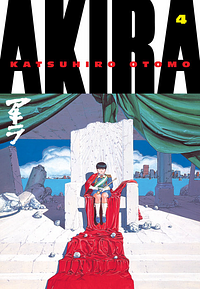Take a photo of a barcode or cover
dark
tense
fast-paced
So when you've blown up one of the world's biggest cities (again), what's the natural progression?
Tax reform? Socialised medicine? Increased endowment to the arts? Start again based on Enlightenment principles?

Or elect an incredibly powerful kid as leader and feed drugs to refugees? Sure, why not.
(It's working out as well as you'd expect.)
This is the fourth volume of the story and I felt revitalised by it. We've gone from futuristic metropolis to bombed-out shithole, and it's glorious. There's a new (self-proclaimed) government turning away offers of assistance, while thousands of people clamour for help. There's not much of a let-up in the action in some places - indeed, Chiyoko's head-busting chops are given more room for expression, which is welcome. (She's a contender for the biggest hard-arse in the work, and she doesn't even have planet-fracturing mental powers so you know there's some premium destruction meted out here.)

Broadly, the fucked city has split: the Empire (Akira et al) on one side, and Miyoko's temple on the other. A lot of backstory is presented in these pages, but it also covers some more internal, philosophical drivers that hint at greater depth to come. There's a lot of conflict, a lot of death, and a feeling that the stakes are increasing, despite the thorns of rivalry. A couple of characters are called upon to transcend their limitations - physical or otherwise - and the forward momentum of the narrative hangs on the outcome of such travails.
Graphically, the work continues to amaze. Even in its destroyed state, the cityscape is breathtaking, and Otomo delivers some wonderfully cinematic tableaux.

Overall, this entry ramped up the tension and the action, I felt. The stirrings of a Tetsuo/Akira stoush-to-come kept me enthralled, even through some ropey group sex/mental breakdown scenes. There's a lot going on, and it's spurring me on in a way I've not felt in other volumes.

More head explosions, thanks!
Tax reform? Socialised medicine? Increased endowment to the arts? Start again based on Enlightenment principles?

Or elect an incredibly powerful kid as leader and feed drugs to refugees? Sure, why not.
(It's working out as well as you'd expect.)
This is the fourth volume of the story and I felt revitalised by it. We've gone from futuristic metropolis to bombed-out shithole, and it's glorious. There's a new (self-proclaimed) government turning away offers of assistance, while thousands of people clamour for help. There's not much of a let-up in the action in some places - indeed, Chiyoko's head-busting chops are given more room for expression, which is welcome. (She's a contender for the biggest hard-arse in the work, and she doesn't even have planet-fracturing mental powers so you know there's some premium destruction meted out here.)

Broadly, the fucked city has split: the Empire (Akira et al) on one side, and Miyoko's temple on the other. A lot of backstory is presented in these pages, but it also covers some more internal, philosophical drivers that hint at greater depth to come. There's a lot of conflict, a lot of death, and a feeling that the stakes are increasing, despite the thorns of rivalry. A couple of characters are called upon to transcend their limitations - physical or otherwise - and the forward momentum of the narrative hangs on the outcome of such travails.
Graphically, the work continues to amaze. Even in its destroyed state, the cityscape is breathtaking, and Otomo delivers some wonderfully cinematic tableaux.

Overall, this entry ramped up the tension and the action, I felt. The stirrings of a Tetsuo/Akira stoush-to-come kept me enthralled, even through some ropey group sex/mental breakdown scenes. There's a lot going on, and it's spurring me on in a way I've not felt in other volumes.

More head explosions, thanks!
***CONTENT WARNING: Sexual Violence, Drug Abuse***
Where the last volume was the perfect length, this one felt bloated. While I greatly enjoyed watching the post-apocalyptic politics of Neo-Tokyo take shape, certain aspects of this concept were less interesting than others. For example, the volume spends a lot of time fleshing out a bunch of (practically) nameless side characters who make up Akira's "army". Their decision to rebel culminates in an overly long takeover of Lady Miyako's sanctuary that I only felt invested in because it put Kei and her friends in danger. It spends precious little time on the newly emerging class of individuals who have "the power", something I found far more compelling.
In a similar vein, the main characters spend the majority of the volume engaged in a game of cat-and-mouse with the surviving child experiments. This section of the plot was overly drawn out and
lost its tension after a while.
In terms of positives:
-Kei and Chiyoko were bombastic, as usual. I loved that this wonderful pair took center stage in this volume
-Art was completely stunning, especially in scenes with characters who have "the power"
-I felt that this was a realistic depiction of the "absent dictator and his evil advisor" political system, as well as the collapse of a micro society in a disaster zone
-Lady Miyako's story was fleshed out and I am fascinated to find out why she told Tetsuo *that*
in the next volume
-Akira continues to intrigue me. Slow burn, indeed
However, this volume has one massive negative, which is ultimately what knocked it down a star.
I was extremely disappointed with the highly sexist role assigned to Kaori. She is worlds apart from the movie adaptation of her character (for obvious reasons). Pages after being introduced as a starving survivor of Akira's destruction, Kaori is made into Tetsuo's sex slave against her will. Further along in the volume, she becomes a mother figure to Akira, who needs are essentially neglected as Tetsuo binges on drugs. The Akira series is full of strong, multidimensional female characters who (before this volume) were barely sexualized outside of Kaneda potentially flirting with them. Kaori's departure is the exception to the rule, but that doesn't mean it's not severely uncomfortable. The novel makes a point to highlight that women are rare commodities in this post-law world, likely because most have been killed or taken as pleasure objects against their will. Kei is consistently subjected to sexualized commentary and at one point is kidnapped by a group of men who try to assault her. I understand that these experiences are far more common than they should be in volatile disaster environments like Neo-Tokyo; however, reading these sections of the book was really hard. They were upsetting and reminded me of the fragility of my own safety, and that I too would be little more than a "commodity" in such an environment. Overall, I felt that the violence against women in this volume was gratuitous, considering how well the female characters have been written so far.
Where the last volume was the perfect length, this one felt bloated. While I greatly enjoyed watching the post-apocalyptic politics of Neo-Tokyo take shape, certain aspects of this concept were less interesting than others. For example, the volume spends a lot of time fleshing out a bunch of (practically) nameless side characters who make up Akira's "army". Their decision to rebel culminates in an overly long takeover of Lady Miyako's sanctuary that I only felt invested in because it put Kei and her friends in danger. It spends precious little time on the newly emerging class of individuals who have "the power", something I found far more compelling.
In a similar vein, the main characters spend the majority of the volume engaged in a game of cat-and-mouse with the surviving child experiments. This section of the plot was overly drawn out and
lost its tension after a while.
In terms of positives:
-Kei and Chiyoko were bombastic, as usual. I loved that this wonderful pair took center stage in this volume
-Art was completely stunning, especially in scenes with characters who have "the power"
-I felt that this was a realistic depiction of the "absent dictator and his evil advisor" political system, as well as the collapse of a micro society in a disaster zone
-Lady Miyako's story was fleshed out and I am fascinated to find out why she told Tetsuo *that*
in the next volume
-Akira continues to intrigue me. Slow burn, indeed
However, this volume has one massive negative, which is ultimately what knocked it down a star.
I was extremely disappointed with the highly sexist role assigned to Kaori. She is worlds apart from the movie adaptation of her character (for obvious reasons). Pages after being introduced as a starving survivor of Akira's destruction, Kaori is made into Tetsuo's sex slave against her will. Further along in the volume, she becomes a mother figure to Akira, who needs are essentially neglected as Tetsuo binges on drugs. The Akira series is full of strong, multidimensional female characters who (before this volume) were barely sexualized outside of Kaneda potentially flirting with them. Kaori's departure is the exception to the rule, but that doesn't mean it's not severely uncomfortable. The novel makes a point to highlight that women are rare commodities in this post-law world, likely because most have been killed or taken as pleasure objects against their will. Kei is consistently subjected to sexualized commentary and at one point is kidnapped by a group of men who try to assault her. I understand that these experiences are far more common than they should be in volatile disaster environments like Neo-Tokyo; however, reading these sections of the book was really hard. They were upsetting and reminded me of the fragility of my own safety, and that I too would be little more than a "commodity" in such an environment. Overall, I felt that the violence against women in this volume was gratuitous, considering how well the female characters have been written so far.
Neo-Tokyo is in complete ruins, Kaneda got engulfed by the massive explosion, Kei is alone with no one around to protect her, and Akira and Tetsuo are leading a new empire in the ruined city. This is still pretty amazing but the misogynist attitude of the men is so rough in this volume and was kind of hard to stomach.
adventurous
dark
fast-paced
Plot or Character Driven:
Character
Strong character development:
Complicated
Loveable characters:
Yes
Diverse cast of characters:
Complicated
Flaws of characters a main focus:
Complicated
Wow, this story took a bit of a turn. Jumping forward some in time, this has now turned into a post apocalyptic story, with gun fights thru ruined streets, refugees and ruffians everywhere.
I am particularly interested in how different this is turning from the movie Akira. Tetsuo seems to be having a much larger and more interesting story arc!
I am particularly interested in how different this is turning from the movie Akira. Tetsuo seems to be having a much larger and more interesting story arc!
dark
tense
fast-paced
Plot or Character Driven:
Plot
Strong character development:
No
Loveable characters:
No
Diverse cast of characters:
No
Flaws of characters a main focus:
No
adventurous
dark
emotional
fast-paced
Plot or Character Driven:
A mix
Strong character development:
Yes
Flaws of characters a main focus:
Yes
Volume 4 seems to continue a little bit after the ending of Volume 3, maybe a few months; I'm not entirely sure. Either way, a lot of stuff happens, whether it's the creation of the Great Tokyo Empire that follows the lead of our eponymous character Akira as supreme ruler (which I personally think is hilarious because Akira is still a child with the most petulant look on his face all the time. Plus, all he seems to do is eat and sleep and sit around on his chair, looking like he would really like to play with toy trucks or something) or the downfall of the radical group, of which Kei and Ryu and Chiyoko were all a part. Kaneda, our mouthy protagonist, isn't a part of Volume 4 and you would understand why if you'd read Volume 3. Is his presence really missed? Nope, because we have a whole bunch of really interesting characters separated by the chaos who are going through some interesting shit and we don't really need to see what Kaneda is up to because that would be way too much to keep track of.
Otomo is still amazing at drawing the destroyed landscapes and destruction scenes. His storytelling is great during the trippy dream sequences, making you really want to know more about both Akira and Tetsuo. There's some tell-not-show parts with Miyako-sama, but it's a manga and that's kind of expected with the genre. There is still a decent amount of showing within that telling sequence however.
The badasses of the manga series continue to be Kei, my homegirl, and Chiyoko (man, this lady is FIERCE).
Otomo is still amazing at drawing the destroyed landscapes and destruction scenes. His storytelling is great during the trippy dream sequences, making you really want to know more about both Akira and Tetsuo. There's some tell-not-show parts with Miyako-sama, but it's a manga and that's kind of expected with the genre. There is still a decent amount of showing within that telling sequence however.
The badasses of the manga series continue to be Kei, my homegirl, and Chiyoko (man, this lady is FIERCE).






